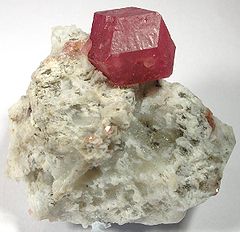- Grossular
-
Grossular 
Grossular dodecahedron, .7 cm across, from Coahuila, MexicoGeneral Category Nesosilicate Chemical formula Ca3Al2(SiO4)3 Strunz classification 09.AD.25 Identification Color light to dark green, light to dark yellow to reddish brown, occasionally translucent to opaque pink. It is also but rarely found in colorless form [1] Crystal system cubic [1] Cleavage none Fracture conchoidal to uneven [1] Mohs scale hardness 7 to 7.5 [1] Luster greasy to vitreous [1] Specific gravity 3.61 (+.12 -.04) Polish luster vitreous [1] Optical properties Single refractive, often anomalous double refractive [1] Refractive index 1.740 (+.12 -.04) [1] Birefringence none Pleochroism none Dispersion .028 Ultraviolet fluorescence near colorless to light green - inert to weak orange in longwave and weak yellow-orange in shortwave; yellow - inert to weak orange in longwave and shortwave [1] Absorption spectra Hessonite sometimes shows bands at 407 and 430nm Major varieties Hessonite yellow-orange to reddish-orange Tsavorite intense green to yellowish green Leuco-garnet transparent and colorless [2] Xalostocite translucent to opaque pink grossularite crystals in marble Grossular or grossularite is a calcium-aluminium mineral species of the garnet group with the formula Ca3Al2(SiO4)3,[1] though the calcium may in part be replaced by ferrous iron and the aluminium by ferric iron. The name grossular is derived from the botanical name for the gooseberry, grossularia, in reference to the green garnet of this composition that is found in Siberia. Other shades include cinnamon brown (cinnamon stone variety), red, and yellow.
The more common variety of grossular is called hessonite from the Greek meaning inferior, because of its inferior hardness to zircon, which the yellow crystals resemble. Grossular is found in contact metamorphosed limestones with vesuvianite, diopside, wollastonite and wernerite.
A highly sought after variety of gem garnet is the fine green Grossular garnet from Kenya and Tanzania called tsavorite. This garnet was discovered in the 1960s in the Tsavo area of Kenya, from which the gem takes its name.
Viluite is a variety name of grossular, that is not a recognized mineral species.[3] It is usually olive green though sometimes brownish or reddish, brought about by impurities in the crystal. Viluite is found associated with and is similar in appearance to vesuvianite, and there is confusion in terminology as viluite has long been used as a synonym for wiluite, a sorosilicate of the vesuvianite group. This confusion in nomenclature dates back to James Dwight Dana.[4] It comes from the Vilyuy river area in Siberia.
Grossular is known by many other names, and also some misnomers;[5] colophonite - coarse granules of garnet[6], ernite, gooseberry-garnet - light green colored and translucent,[7] kalkthongranat, kanelstein, olyntholite/olytholite, pechgranat, romanzovite, and tellemarkite. Misnomers include;[2] South African jade, garnet jade, Transvaal jade, and African jade.
See also
- Hydrogrossular
- Hydrogarnet
References
- ^ a b c d e f g h i j Gemological Institute of America, GIA Gem Reference Guide 1995, ISBN 0-87311-019-6
- ^ a b Grossular The Mineral and Gemstone Kingdom, accessed online January 25, 2007
- ^ Viluite Mindat database
- ^ The System of Mineralogy of James Dwight Dana. Descriptive Mineralogy By James Dwight Dana, Edward Salisbury Dana, 1892, p. 479-80
- ^ Grossular Mindat mineral database, accessed January 25, 2007
- ^ Colophonite The Free Dictionary, accessed online January 25, 2007
- ^ Gooseberry Garnet WordWeb Online
 Color range of grossular graphically displayed at the National Museum of Natural History, Washington, D.C.
Color range of grossular graphically displayed at the National Museum of Natural History, Washington, D.C. Categories:
Categories:- Calcium minerals
- Aluminium minerals
- Gemstones
- Garnet group
Wikimedia Foundation. 2010.

